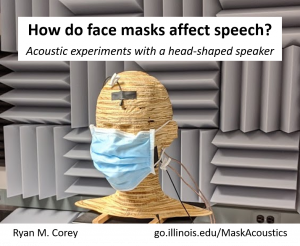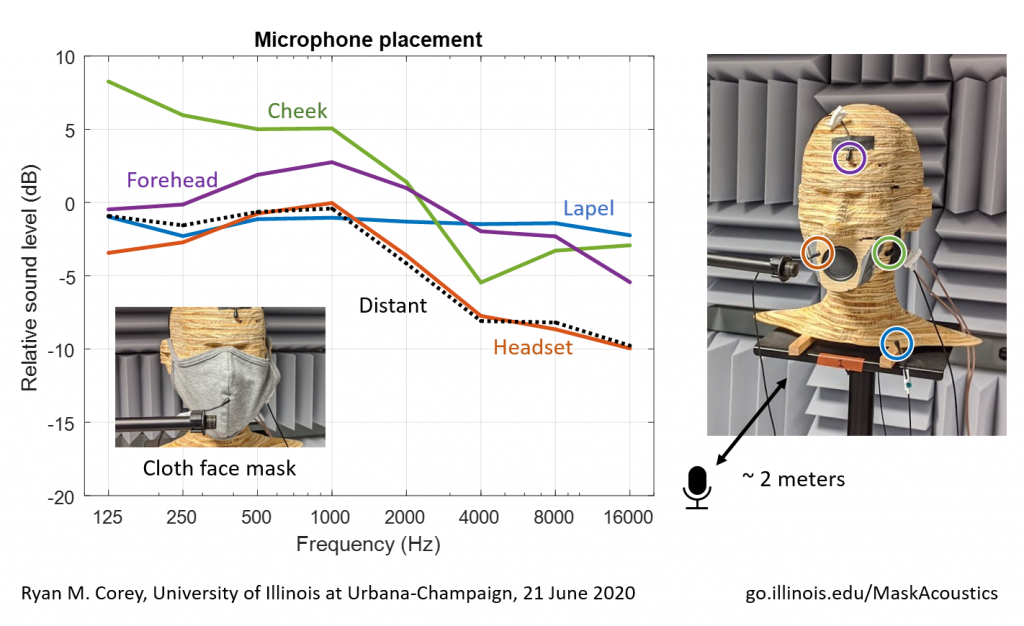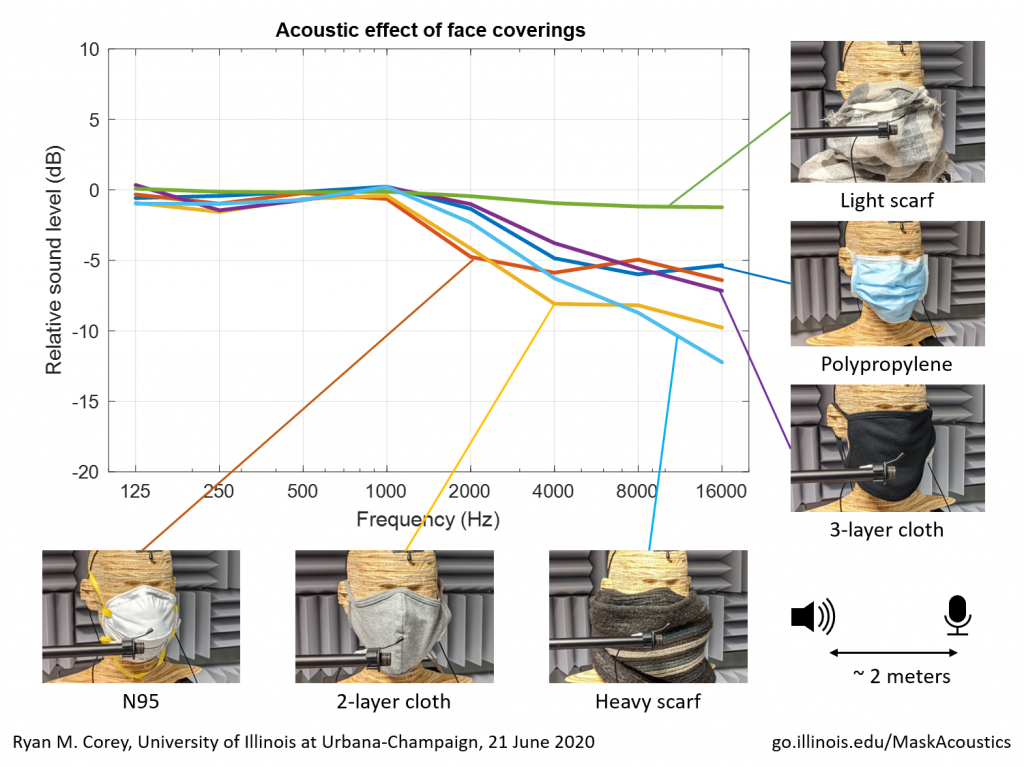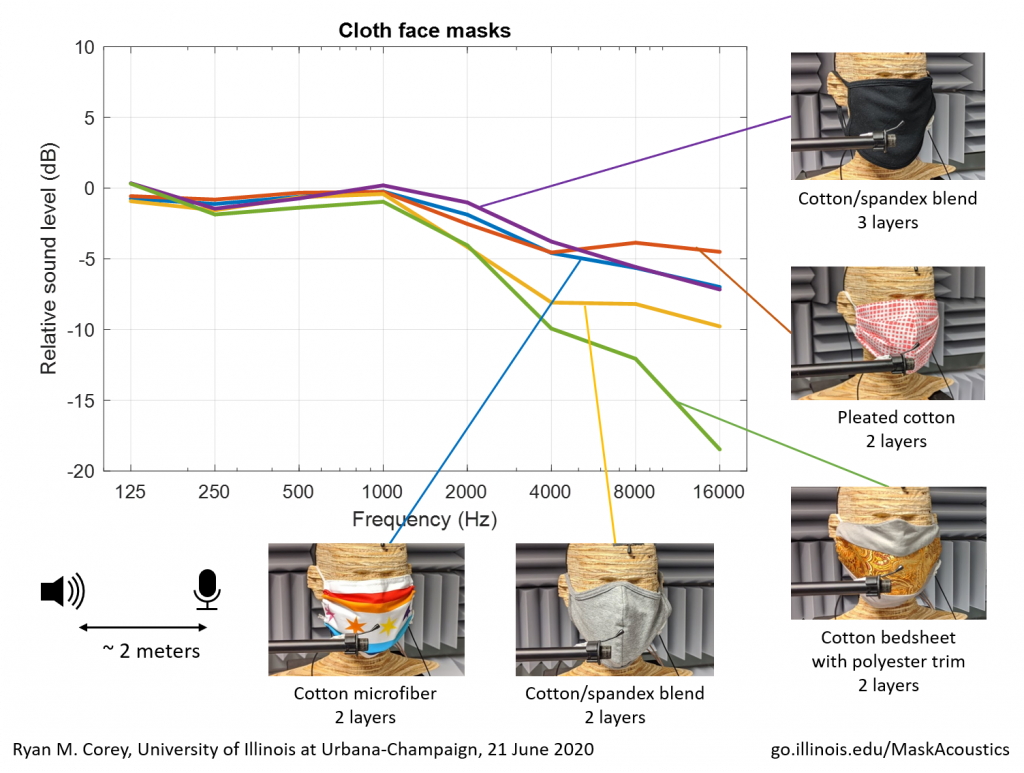This post from June describes our initial experiments on face mask acoustics, which have since been expanded and published.
Please see our new post with updated results!
The original post is preserved below.

Face masks are a powerful tool to prevent COVID-19 transmission, but they also make it more difficult to hear. Many businesses and schools will require face coverings for workers, customers, teachers, and students as they return to in-person operations. Everyone, but especially people with hearing loss, will have to endure months of frustration as they try to talk to each other through masks. Because a pandemic is stressful enough already, we decided to study the ways that face masks affect speech and look for ways to make it easier to communicate while wearing one.
There are two ways that masks make it harder to understand speech. First, they muffle speech sounds, especially the higher frequencies that help us distinguish between similar sounds. Second, they block visual cues, including facial expressions and lip positions that help us understand speech. It is unclear which of these effects is most harmful, and it is difficult to quantify the effects of visual cues. However, we can measure the acoustic effects of face masks on speech sounds using some unique equipment in the Illinois Augmented Listening Laboratory.
Last year, industrial design student Uriah Jones built a head-shaped loudspeaker designed to imitate the acoustics of human speech. While we planned to use it to study hearing aids, it is also perfect for measuring mask acoustics. We set up the speaker in our acoustically treated laboratory and equipped it with ten different face coverings, including medical masks, cloth masks, and scarves. For each mask, we made recordings of both a frequency-sweep test signal and a set of speech clips from the open-source VCTK data set with several microphones.
Mask Measurements
To compare the acoustic effects of different masks, we recorded audio with a microphone at head height about six feet away from the speaker. The plot below shows how sound was attenuated with different masks compared to the same signal with no mask. The masks had virtually no effect below 1 kHz because at those frequencies, sound wavelengths are much larger than any dimension of the mask. The masks do block sound at higher frequencies, which are important for understanding certain speech cues. Hearing loss usually affects these higher frequencies more than lower frequencies, making masks especially harmful for hearing-impaired listeners. The acoustic effect of a face mask is equivalent to a slight high-frequency hearing loss.
The different face coverings have different effects on the speech signal. The medical masks attenuate higher frequencies by around 5 dB, which is enough to be noticeable but not too detrimental by itself. Though the plot only shows a polypropylene and N95 mask, we also tested the easier-to-find KN95 and found that it performs similarly to the N95. The light scarf, which is so thinly woven that one can easily see through it, has almost no effect on the sound (but it probably offers little protection against droplets!). The heavy winter scarf is thick enough to absorb high-frequency sound waves, so it muffles the sound severely.
Cloth face masks, which are widely used and are likely to be worn in schools this fall, showed surprising results: the thick black mask blocks less sound than the thin gray mask. To understand the differences between cloth masks, we compared several more with different materials and weaves, as shown in the plot below. It appears that the weave of the fabric may be more important than the thickness or number of layers for sound propagation. They masks with finer fibers and tighter weaves, like bedsheets, blocked more sound than looser fabrics, like t-shirt cotton. We plan to perform more experiments to understand the acoustics of different fabrics.
Sound Reinforcement
Since we will probably be wearing masks for a long time, how can we help people to communicate better while their faces are covered? In some environments, such as classrooms, sound reinforcement systems might help. A microphone is placed on or near the talker, such as a teacher, and the signal is amplified and played back through loudspeakers. Many classrooms already feature sound reinforcement or wireless transmission systems for students with hearing loss. Could these systems work with face masks, and if so, where should the microphone be placed?
To find out, we placed four microphones on and near the head-shaped loudspeaker: One on the cheek, one on the forehead, one underneath the chin—where a lapel microphone would be if our “talker” had a lapel—and one just in front of the mouth, like a headset. The plot below shows the difference in sound level at each microphone between no mask and the gray cotton mask. The “headset” microphone in front of the mouth experienced about the same attenuation as the microphone at the listening position, but the other three had less. In fact, low-frequency sound was slightly amplified for the cheek and forehead microphones.

Effect of a two-layer cotton/spandex face mask on sound captured by microphones on and near the face
There is a simple acoustic explanation for this effect. Face masks are too thin to absorb sound energy the way a thick pillow would; instead, they block sound by reflecting it. Thus, less sound gets through to the front of the mask, but more sound comes out the sides. This observation could also explain why the weave of the fabric appears to matter more than its thickness: tightly woven fabric may be more reflective. We will need to do more experiments to understand how sound propagates through and around face masks.
It appears that lapel microphones should work well for sound reinforcement. The “lapel” microphone in our setup experienced a small, uniform drop in sound level across all frequencies and for all types of mask, so existing lapel-microphone systems will likely work with little modification. Cheek and forehead microphones are also viable but may need to be equalized to balance the effects of the mask. Microphones placed in front of the mask may be less effective and will require extra high-frequency amplification. To verify these results, we will need to repeat this experiment with a live human talker wearing more types of microphone.
Takeaways
This experiment offers some useful takeaways for anyone planning to work, teach, or just go about their life while wearing a face covering:
- Face masks attenuate high-frequency speech sounds enough to affect hearing, but the acoustic effect is mild enough that the loss of visual cues might be a larger problem.
- Medical face masks (polypropylene and N95) perform well acoustically. Since they are also effective against the virus, they are a good choice if you can get them.
- For cloth masks, it appears that loosely woven fabrics are better acoustically than tightly woven fabrics, regardless of the thickness or number of layers. (But make sure your mask is effective at blocking droplet transmission!)
- Lapel microphones should work normally with all kinds of face mask and can be used for sound reinforcement.
We plan to continue this research by conducting experiments with live human subjects, studying more types of fabric, and testing transparent face coverings such as shields. We also hope to correlate our findings about mask acoustics with research about droplet transmission to find a mask that can block the virus but that does not interfere too much with speech. Please reach out to us if you have questions or suggestions about this project!


